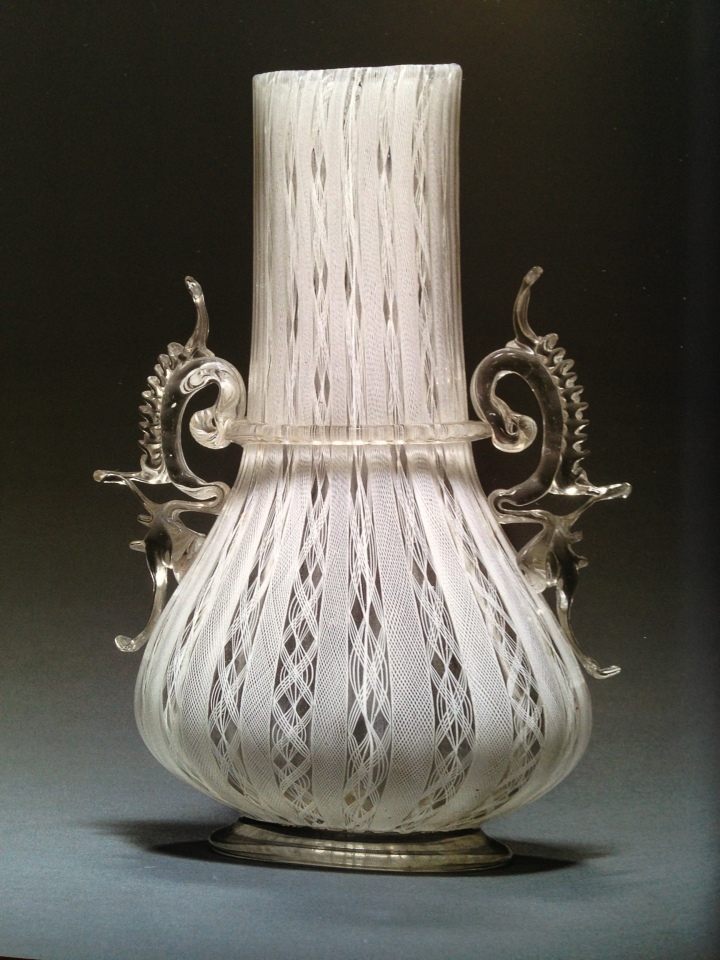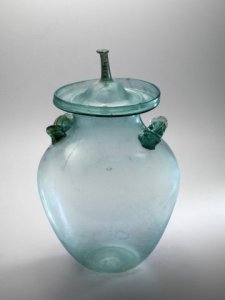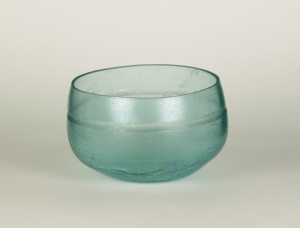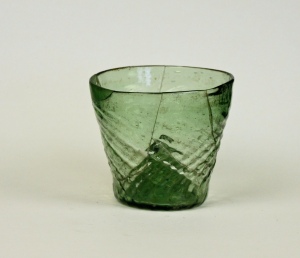Venetian Filigrana Glass Vase
Venetian Filigrana Glass Vase
The pear-shaped body of this Venetian vase is fashioned with two styles of filigrana retortoli canes. The straight neck may have had a lid. The vessel is decorated with clear glass wing handles, single center trail and ring foot also of clear glass. A similar object is in the collection in the Rosenborg Castle in Copenhagen.
H: 12.7
D: 1700 Venice
Published: A Collection of Filigrana Glass, Kitty Lameris, 2012 #20
Ref: Coburg #452, HansCohn Collection #201, Golden Age of Venetian Glass #127
Photo courtesy of Frides Lameris Art and Antique, Amsterdam
MEDIEVAL GLASS VESSELS, RARE AND UNUSUAL
Rare and Unusual Medieval Glass Vessels
- Beaker 9th-10th C. Statens Historiska Museum, Stockholm
- Beaker C. 1282 Hallisch-FranKisches Museum
- Ribbed Beaker 13th-early 14th C. Rheimisches Landesmusuem. Bonn
- Beakker 14th-early 15th C.
- Beaker Early 16th C. Sammlung Nassauischer Altertumer
- Krautstrunk End of 15th-early 16th C. Kunstgewerbemuseum, Prague
- Beaker 1st half of 16th C. Landesdenkmalamt Baden-Wuttemberg
- Pilgrim Flask 1520-1540, Hessisches Landesmuseum, Darmstadt
- Dish C. 1250-1350 Glasmuseum Hentrich, Dusseldorf
- Keulenglas C. 1500 The Corning Museum of Glass
- Stangenglass, first half of 15th C. Collection of Karl Amendt
- Lid for a beaker, first half of 16th C. Collection of Karl Amendt
- Scheuer, 2nd half of 13th C. Collection of Karl Amendt
AMBER RIBBED BOWL (zarte Rippenschale)
AMBER RIBBED ROMAN BOWL (zarte Rippenschale) of Hans van Rossum
First half of 1st century AD | Roman Empire with areas of concentration in northern Italy, Dalmatia, Carniola (Slovenia) and the Ticino area
Size↑5.5 cm | ø 7.8 cm | Weight 44 g
Technique: Probably combination of a mold and free blown, tooled
Classification: Isings 1957 form 17
Description: Translucent amber glass, the flaring and widened mouth with a cracked-off rim cover a squat spherical body, blown into a mold and decorated with nineteen ribs which are connected by an arch. Flattened base, no pontil mark.
Condition: Rim chipped, body with incredible silvery and golden iridescence
Remarks: Because the exact procedure of shaping the ribs is still disputed, more information about the way in which the Roman glass-maker possibly could have made this zarte Rippenschale, with thanks to Theo Zandbergen (NL), David Giles (UK) and Mark Taylor & David Hill of the Roman Glassmakers, London. The body color (blue, brown, etc.) is formed as a small bubble to start with. Then, in case of a thread decoration, a spiral of white (usually starting with the attachment at the bottom, though not always – you can usually see it at the centre of the base – resembling a ‘tadpole head’) going round the paraison all the way up towards the iron. (the trailing above the ribs might be applied separately at the end of the process) Re-heat, then a small amount of inflation, then pushing into the optic mold (star pattern) which then makes the whole paraison look like the centre of one of those glass lemon squeezers. Re-heat, then a bit more inflation, then use the pincers to squeeze a generous rib out using the protruding bits of the stars. Using the pincers now has the effect of cooling the ribs (sucking heat out from them, and the re-heats never fully warm these through again), and because they are stiffer, they will not expand as much as the body of the glass when it is inflated again. The ribs are only a tiny bit inflated in the mold as markers and then it is blown much more in free blowing and is also pulled around by tools and pinchers. In that process the position of the ribs is becoming distorted and sometimes misshaped. The ribs, with the stiff glass, stay the same, with their vivid contrasting color-way, but because the vessel body expands, to become much thinner, it stretches both the body color and the white so thin that sometimes the white is made to almost appear to fade out. But it is always there. The arches, some bowls have, are occurring naturally as the glass overflowed the short mold and expanded outwards. It looks as if it is a curved mold, the glassmaker used but it is not. It is just a natural bridge which does not always occur on examples of these bowls and depends how much puff or inflation the glassmaker gave to it when in the mold.
Provenance: anonymous sale; Piasa Drouot Paris, auction 2 June 2006, lot 61
Reference: Gläser der Antike, Sammlung Oppenländer, A. von Saldern no. 265 (5.4 x 7.6 cm) The Fascination of Ancient Glass, Dolf Schut Collection, M. Newby and D. Schut no. 1 (5.7 x 8.0 cm) Bonhams London, auction 27 April 2006 lot 223 (5.5 x 6.8 cm) Vetri antichi del Museo Civico Archeologico di Padova, G. Zampieri no. 276 (6.7 x 9.7 cm)
Literature: ‘Die Verbreitung der ‘’zarten Rippenschalen’’ T. E. Haevernick in Jahrbuch des Römisch-Germanischen Zentralmuseums Mainz, 14. Jahrgang 1967
MEROVINGIAN GLASS CUPS (5th – 7th C)
MEROVINGIAN GLASS CUPS (5th – 7th C)
“The most frequent form of cup is a small hemispherical or bell-shaped vessel that would fit in the palm of one’s hand: hence the name “palm cup.” Palm cups may have a plain, fire-polished rim or rim that was folded out and down to produce the appearance of a collar. As with most other varieties of early medieval drinking vessels, cups may be undecorated or have dip-molded ribs or trails.” Taken from the book: Medieval Glass for Popes, Princes, and Peasants by David Whitehouse (2010) Below are pictures of plam cups from various and collections.
- 114E Allaire collection
- Bavarian State Archaeological Museum
- The British Museum
- The British Museum
- The British Museum
- The British Museum
- The British Museum
- The British Museum 5-7th C
- Houston Art Museum
- Römisch-Germanisches Museum
- Römisch-Germanisches Museum
- Römisch-Germanisches Museum
- Römisch-Germanisches Museum
- Römisch-Germanisches Museum
- The Metropolitan Museum of Art
- The Musee d Archeologie Nationale
- The Musee d Archeologie Nationale
- The Musee d Archeologie Nationale
ANCIENT ROMAN GLASS AT THE PRINCETON UNIVERSITY ART MUSEUM
ANCIENT ROMAN GLASS AT THE PRINCETON UNIVERSITY ART MUSEUM
The Princeton University Art Museum is one of the nation’s finest art museums, housing collections of over 72, 000 works of art spanning 5,000 years of world history and all the world’s major cultures. The Museum also presents special exhibitions and educational programs throughout the year. Admission is free. It is located at the heart of Princeton University, one of the world’s great research universities in the charming small-city setting of Princeton, New Jersey.
The glass collection is about 509 glass vessels, plaques, and inlays from the Greek, Roman, Byzantine and Islamic periods. The bulk of the glass vessels are Roman from the eastern Mediterranean region. There is a new publication on this collection Fire and Sand: Ancient Glass in the Princeton University Art Museum, Anastassios C. Antonaras, author.
The following pictures are from this collection. Click on the thumbnails below to enlarge.
- Fire and Sand Ancient Glass in the Princeton University Art Museum Anastassios C Antonaras author
- Entrance to The Princeton University Art Museum
- Side view The Princeton University Art Museum
Leave a Reply
NATIONAL MUSEUM OF THE RENAISSANCE in the Chateau d’Ecuen
NATIONAL MUSEUM OF THE RENAISSANCE IN FRANCE
The Château d’Écouen, in Écouen, north of Paris which today houses the National Museum of the Renaissance (opened in 1982) was built between 1538 and 1555 as commanded by Anne de Montmorency, an extremely wealthy and influential advisor to François the First, king of France. Today, as well as offering the opportunity to observe this impressive example of 16th century architecture, the museum displays collections of the Musée de Cluny comprising Renaissance objects including paintings, sculpture, textiles, furniture, metalwork and glass.
The glass collection is excellent, comprising mainly Venetian, Facon de Venise, and Spanish examples from the 16th and 17th Centuries. Click on the pictures to enlarge them and use Esc to get back to this page.
ROMAN GLASS OF THE FIRST CENTURY
ROMAN GLASS OF THE FIRST CENTURY
The glass blowing revolutionized the Roman glass industry of the first century. It allowed, for the first-time, glass to be sold to the average Roman. Also with blowing an object could be made much larger as well as quickly. Before this glass was only a luxury item as rare as gold or precious stones. This was mainly caused by the time it took to make core-formed objects (45 minutes) or casting or cutting techniques (several days) and size and technology of furnaces. Glass blowing is a process of forming an object quickly and in many different sizes and shape. Simply, it is blowing air through a metal tube (blow pipe) into a mass of molten glass. This short clip from Corning Museum of Glass by Bill Gudenrath explains it clearly (active link). Glass blowing was developed probably by Romans in Syria or Phoenicia (now the region of modern Lebanon) in 50 to 75 B.C. If not discovered by the Romans it was certainly exploited by them throughout the Empire.
Below are some examples of blown glass objects of the first century from the Allaire collection and the collections of our contributors.
From the collection of Joop van der Groen(active link)
- DARK PURPLE UNGUENTARIUM
- RARE GREEN UNGUENTARIUM
–
From the collection of The Windmill Collection of Roman Glass(active link)
- two-handled beaker or scyphos
- Roman Glass Acetabulum The Windmill Collection of Roman Glass
- Roman Glass Acetabulum
–
From the collection of Nico F. Bijnsdorp(active link)
- ROMAN ASKOS
- Roman splashed glass aryballos 1st C Nico F. Bijnsdorp
- ROMAN MARBLED BIRD
- ROMAN GLASS TRULLA
- CINERARY URN of Nico F. Bijnsdorp
–
From the collection of of David Giles(active link)
- OPAQUE BLUE ROMAN GLASS JUG SIDE B
- OPAQUE BLUE ROMAN GLASS BUD VASE 1st C David Giles
–
From the collection of Hans van Rossum(active link)
- Melted Roman bottle
- ROMAN SIMPULUM
- Lidded Roman Pyxis Mid-late 1st century AD | Eastern Mediterranean, probably Syria
- Roman Glass Jug with Long Neck of Hans van Rossum
- 4H Roman Glass Aryballos with Four Handles
- INDENTED CUP of Hans van Rossum
- TWO PERFUME BOTTLES
- TWO PERFUME BOTTLES
- POINTED UNGUENTARIUM
- THIN-WALLED ARYBALLOS
- Roman squat carinated blue bottle 8.9 cm Hans van Rossum collection
- RIBBED AMPHORISKOS
–
From the Allaire Collection of Ancient Roman Glass(active link)
- 2R Beaker with Wheel Cut Lines 1st C
- 12R Piriform unguentarium 1st Century
- SMALL SILVERY ROMAN BOTTLE 1-2nd C
- 08R Tear bottle 1st Century
- 25R Aubergine two handled bottle 1st Century : 8 cm
- 27R Free blown technique. Roman glass skyphos with two handles and thumb rests 1st Century from the Allaire Collection.
- 29R Hofheim cup with wheel-cut lines 1st Century (https://wp.me/pqEUT-36T active link)
- 31R Single Handled Pitcher 1st C
- 41R Small dark green Roman glass bottle 1st Century Allaire Collection
- 17R Roman blue bottle 1st Century
- 42R Blue bottle with trailling 1st Century
- 54R Roman Marbled Blue Bottle 1st Century
- 61R Small cup (acetabulum) 1st Century (https://wp.me/pqEUT-jN active link)
- 63R Roman bowl with vertical rim 1st Century (https://wp.me/pqEUT-3ma active link)
- Roman Aryballos 68R 1st-2nd C Allaire collection
- 70R ROMAN GLASS BEAKER, H: 10.2 cm, Rim D: 8.5 cm, Date: 1st – early 2nd century, Possibly Western Allaire Collection
- 20R Roman two handled bottle 1st Century
- 60R Roman bowl with trail 1st-2nd Century (https://wp.me/pqEUT-SS active link)
THE VICTORIA AND ALBERT MUSEUM, GLASS COLLECTION HIGHLIGHTS
The Victoria and Albert Museum
The Victoria and Albert Museum, London, is the world’s largest museum of decorative arts and design, housing a permanent collection of over 4.5 million objects. It was founded in 1852 and named after Queen Victoria and Prince Albert. The glass collection covers 4000 years of glass making, and has over 6000 items from Africa, Britain, Europe, America and Asia. The earliest glassware on display comes from Ancient Egypt and continues through the Ancient Roman, Medieval, and Renaissance covering areas such as Venetian glass and Bohemian glass and more recent periods, including Art Nouveau glass by Louis Comfort Tiffany and Émile Gallé. The Art Deco style is represented by several examples by René Lalique. There are many examples of crystal chandeliers displayed in the British and Venetian galleries attributed to Giuseppe Briati dated c1750. The stained glass collection is possibly the finest in the world, covering the medieval to modern periods, with examples from Europe as well as Britain. Several examples of English 16th-century heraldic glass are displayed in the British Galleries. Many well-known designers of stained glass are represented in the collection including, from the 19th century: Dante Gabriel Rossetti, Edward Burne-Jones and William Morris. There is also an example of Frank Lloyd Wright’s work in the collection and other 20th-century designers. Most of the glass pictures below are from the museum’s own web site.
- Alembic cap 19th Centure
- Bavaria tankard 1655
- Beaker (passglas) 1650-1720
- Beakers from German early 17th century
- Bohemia, Czech Republic beakers 1616
- Bohemia, Czech Republic glass vessels 1599
- Calcedonio glass from Venice 1500-1520
- Egyptian core-form glass 1336 BC-1213 BC
- Egyptian core-formed unguent glass jar 1400 BC-1336 BC
- Enamelled glass bottle, with pewter mount 18th Century USA or Germany
- Filigree glass goblet from Venice 1600-1725
- Filigree glass tazza from Venice 1550-1650
- Filigree vase, Venetian glass; 1550-1625
- Flute from Netherlands 1575-1625
- Footed bowl from Venice last quarter 15th century – early 16th century
- Footed glass bowl from Venice 1475-1525
- German drinking cup 1650 – 1675
- German siphon glass 1650-1720
- Glass beakers found in England 6th century
- Glass tazza from Venice 1550-1600
- Goblet from London, England 1586
- Goblet from Venice 1500-1550
- Goblets, Italy (Venice), made by Salviat 1866
- Horn, Netherlands (probably Middelburg or Antwerp), 1550-1600.
- Ice-glass beaker from Netherlands 17th Century
- Islamic bottle, glass with wheelcut facets with central roundels, 900-1000, Iran
- Islamic glass Mosque lamp, Mamluk Egypt, 1382-1400
- Krautstrunk beaker from German 15th century-early 16th century
- Onion shaped wine bottle, England, 1710-1730
- Over view of Frankish and Merovingian glass 2
- Over view of Frankish and Merovingian glass
- Part of the main glass gallery room 131
- Roman glass 1st-2nd century 2
- Roman Glass 1st-4th Century
- Roman glass bottle 2nd century
- Roman glass late 2nd century BC-1st century BC
- Roman juglet from Sidon 1st Century Unknown Collection
- Rosewater sprikler (almorratxa), Catalonia, Spain, 1550-1650
- Ruby glass goblet with cover from Bohemia, Czech Republic mid 19th century
- Ruby glass set from Germany 1700
- Sculpture in Glass from Scotland 1991
- Spainish glass vessels 16th-17th century
- Stained glass panel, depicting Christ’s resurrection, Germany, c. 1540–42
- The Luck of Edenhall, glass beaker, Syria, 13th century
- Tiffany Favrille glass from USA
- Water jug from Spain 17th-18th century
- Whitefriars Tumblers 20th century
- Wine glass Roemer with Rassberry Prunts, probably Netherlands, possibly engraved by G.V. Nes, 1650-1690
- Wine Glass Facon de Venise
- Wine glasses (Roemers), Germany or Netherlands, 1625-1699
- Wine glasses from England 1759
GLASS OF LATE MEDIEVAL EUROPE AND ROEMERS
SUMMARY OF GLASS HISTORY DURING MIDDLE AGES IN WESTERN EUROPE
During the 1,000 years of the Middle Ages also referred to as the Dark Ages, Europe underwent profound changes. David Whitehouse in Medieval Glass for Popes, Princes, and Peasant the book for the 2010 exhibition at The Corning Museum of Glass divides this period of history into three sections. The Early Middle Ages from the fifth to the eighth century, the Central Middle Ages starting with the eighth to the eleventh and the Late Middle Ages 12th to 14th centuries. Some scholars refer to Early Middle Ages also as the Migration Period.
Glass from the Early and Central Middle Ages is mostly a story of drinking vessels, bowls, cups, beakers, drinking horns, and bottles. In the later period drinking vessels start to decline in importance with the rise of stained glass used for the windows of cathedrals. The oldest-known fragments of medieval pictorial stained glass appear to date from the 10th century. The earliest intact figures are the five prophet windows at Augsburg Germany, dating from the late 11th century. At Canterbury and Chartres Cathedrals, a number of panels of the 12th century have survived. Most of the magnificent stained glass of France is in the famous windows of Chartres Cathedral, date from the 13th century. So important and beautiful are stained glass windows in the Middle Ages that generally, that is all you hear about on the subject of Medieval glass. Most of the glass vessels produced in the later Middle Ages in northern Germany, the Low Countries, and central Europe were made of transparent green Waldglas or foresglass. The color came from the presence of impurities (iron oxide) in the raw materials. This type of glass particularly the Berkemeyer and Krautstrunk evolved in the 17th century into the Roemer.
Parts of this article come from the book written by David Whitehouse, Medieval Glass for popes, Princes, and Peasant,2010 and an article in Glashistorisch Tijdschrift nr.138. By Theo Zandbergen
GLASS FROM THE LATE MIDDLE AGES
IN THE ALLAIRE COLLECTION
–
13E KRAUTSRUNK BEAKER
23E MEDIEVAL MAIGELEIN
49E MEDIEVAL MAIGELEIN
74E WARZENBEACHER (wart beaker)
86E MEDIEVAL BEAKER WITH STEM FOOT
105E KEULENGLAS BEAKER
109E RIDGED BEAKER WITH DISTINCT FOOT
110E TRAILED BEAKER FROM THE NETHERLANDS
120E SINGLE KUTTROLF FROM THE MIDDLE AGES
 120E Single Kuttrolf 16th Century
120E Single Kuttrolf 16th Century
–
ROEMERS
Later Engraved Roemer
Engraved Roemer
Later Engraved Roemer
SHALLOW ROEMER
LARGE GREEN ROEMER
12E EARLY ROEMER
40E EARLY ROEMER
56E EARLY ROEMER
45E LARGE COLORLESS ROEMER
46 A&B A PAIR OF MATCHING ROEMERS
48E LIGHT GREEN MODERN ROEMER
50A ROEMER WITH SPHERICAL PRUNTS
57E ENAMELED ROEMER (Ray’s Roemer)
58E LARGE GREEN ROEMER
59E LARGE DUTCH ROEMER
106E SMALL GREEN ROEMER
Core and Rod-Formed Early Glass Objects
Core and Rod-Formed Glass Objects 6th BC. To 4th AD.
Methods of making glass objects came about shortly after glass was discovered. The first glass objects manufactured were not vessels but amulets or pendant and beads (see example Pendant nfb 270). Vessels were made later by core winding (all of rest of the examples) from 1500 to 1200 BC. in the Mesopotamia, Egypt and Eastern Mediterranean region. Production declined between 1200 and 800 but revived from 800 to the 1st century BC. After the introduction of glass blowing by the Syrians 100 BC, the method ceased to be used with few exceptions (see Miniature core form jug). A good scholarly book on this type of glass is Early Ancient Glass, David Grose, Toledo Museum, 1989.
This link is to a short video from Corning Museum of Glass on these methods. (http://www.cmog.org/video/core-formed-vase)
–
The Augustinus Collection of Ancient Glass active link
FOUR CORE-FORMED FISH SHAPED GLASS BEADS active link
CARTHAGINIAN HEAD PENDANT
–
Below
From the collection of Nico F. Bijnsdorp active link
–
CORE-FORMED OINOCHOE active link
ROD-FORMED HEAD PENDANT active link
ROD-FORMED KOHL TUBE WITH STOPPER active link
–
From the collection of Elisabeth & Theo Zandbergen active link
–
CORE FORMED ALABASTRON active link
CORE FORMED OEINOCHOE active link
SMALL CAN BE BEAUTIFUL, A CORE FORM JUG active link
–
From the Allaire collection
Core-Formed Alabastron 26R active link
































































































































































































































































leave a comment